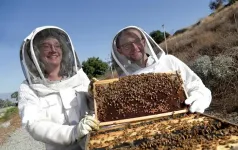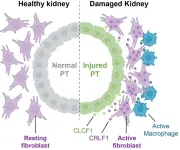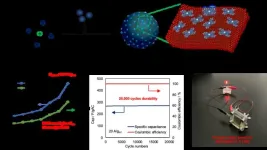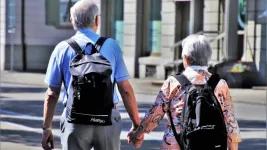(Press-News.org) PULLMAN, Wash. — A new application that uses artificial intelligence may revolutionize the way scientists study hair and could lead to the development of health diagnostics based solely on hair.
The AI model speeds up and streamlines the hair quantification process, allowing a microscope to scan slides and collect images of hundreds of hairs at a time. In a matter of seconds, it can capture an abundance of high-resolution data that is then processed with a deep learning algorithm that collects the color, shape, width and length of each individual hair. Researchers tested it using mouse fur, but it could be applied to hair of any species including humans.
Research behind the application, conducted and developed by scientists at Washington State University’s College of Veterinary Medicine, was published in the Journal of Investigative Dermatology.
“In many ways an individual’s hair is somewhat a reflection of health, and if you start separating them out with tweezers, which a lot of hair scientists do, you can make some really interesting discoveries, but you’re doing this manually, right underneath the microscope,” Ryan Driskell associate professor and principal investigator of the research said. “So, the idea was what happens if you can make a computer program do that for you?”
The concept for the application was dreamt up by Jasson Makkar, a molecular biosciences graduate student at WSU who was tasked with the monotonous job of manually separating thousands of hairs for various research projects focused on hair and skin in Driskell’s lab.
To bring that idea to life, Makkar trained an AI computer vision model to identify hair using WSU’s high-performance computing cluster, Kamiak. With the added help of the Aperio GT450 microscope at the Washington Animal Disease Diagnostic Laboratory, high resolution imaging of the hair fibers was automated.
The application has many implications, including in forensics and the hair product industry, but allowing scientists to assess the health of a person or animal through their hair is perhaps the greatest of all, Makkar said.
By determining longitudinal data points for what healthy hair looks like in each species, he said a scale could be created for human doctors and veterinarians to grade overall health based on hair. Different conditions, such as hormonal imbalances or nutritional deficiencies, alter hair growth in ways that can be detected and potentially used for diagnosis.
The new technology could not only identify the species a hair is derived from but also shed light on age, health, and ethnicity in humans, which could aid criminal investigations.
“There’s this methodology in law enforcement agencies that utilizes hair fiber classification as a forensic tool in criminal investigations,” Driskell said. “This methodology has been somewhat controversial because much of this work was performed by forensic technicians visually identifying hair types found at a crime scene and then cross-referencing them against a limited database of hair types across all mammals.”
Driskell added the technology allows scientists to not only perform highly accurate cross-referencing of hair fibers in an unbiased manner but also generate a large enough database to accurately quantify hair types from different individuals and possibly anatomical positions.
Using these same tools, Makkar said assessing the effects of various hair products on hair is another capability the application brings.
“Take a swatch of hair, apply the cosmetic that you’re testing to it and then look at it with our deep hair phenomics tool and see how it changes,” Makkar said.
The data generated in this study is available through an interactive webtool at skinregeneration.org.
END
New AI hair analysis method holds promise for improved health research
2024-09-05
ELSE PRESS RELEASES FROM THIS DATE:
Cells, data, stars: Three new ERC Projects at ISTA
2024-09-05
A combined 4.8 million euros in ERC Starting Grants will go to scientists at the Institute of Science and Technology Austria (ISTA). Awarded to early career researchers by the European Research Council (ERC), Starting Grants help researchers launch and develop projects, build capable teams, and pursue cutting-edge research. All three of ISTA’s ERC winners wholly embody the Institute’s curiosity-driven mission: they aim to find out how cells keep time, improve the way we date our stars, and optimize the extraction of relevant information from our ever-growing data.
ERC Starting Grants ...
Weather in deep space -- Trinity astrophysicist wins European Research Council Starting Grant
2024-09-05
Drs Johanna Vos has won a highly prestigious European Research Council (ERC) Starting Grants to pursue research aimed at better understanding weather patterns in extrasolar worlds deep in the galaxy.
Dr Vos’ project: Exometeorology: Probing Extrasolar Atmospheres (Exo-PEA)
Over the past 30 years, astronomers have uncovered thousands of new extrasolar planets, which vary from small, rocky worlds, to giant planets like Jupiter. Additionally, lots of isolated or free-floating worlds have been discovered. We have already learned that the atmospheres of these strange worlds are highly complex, hosting a range of weather processes.
The launch of the James Webb Space Telescope ...
European Research Council awards €780 million in grants to emerging science talent across Europe
2024-09-05
Iliana Ivanova, Commissioner for Innovation, Research, Culture, Education and Youth, said: “The European Commission is proud to support the curiosity and passion of our early-career talent under our Horizon Europe programme. The new ERC Starting Grants winners aim to deepen our understanding of the world. Their creativity is vital to finding solutions to some of the most pressing societal challenges. In this call, I am happy to see one of the highest shares of female grantees to date, a trend that I hope will continue. Congratulations to all!”
President of the European Research Council, Prof. ...
Seeking the secrets to brain repair -- Trinity scientist wins European Research Council Starting Grant
2024-09-05
Dr Michael-John Dolan has won a highly prestigious European Research Council (ERC) Starting Grants to pursue research aimed at uncovering the secrets of brain disorders and repair.
Dr Dolan’s project: MICRODISSECT: Dissection of Microglial State Biology in Brain Repair
Dr Dolan’s research will focus on microglia, the brain's resident immune cells, which can form distinct subtypes, or “states” – especially during brain damage, disease, or repair. While microglia are crucial for regulating neuroinflammation and brain repair, these states are poorly understood ...
A $1.2 million Rosetta stone for honeybees
2024-09-05
If you upset one bee, what determines whether the entire hive decides to avenge her grievance? A $1.2 million grant will support UC Riverside scientists in answering questions like these about how honeybees communicate.
Every third bite of food you eat has been pollinated by a bee. They are central to worldwide food production, but there have been an alarming number of die-offs recorded since 2006. One solution to this issue is the use of special survivor bees that are more resistant to pests and diseases that are killing managed honeybees.
Commonly found in ...
ERC Starting Grant for IPK root researcher Prof. Dr. Hannah Schneider
2024-09-05
“We are extremely happy about the freshly granted ERC project for Hannah Schneider. Thereby, the European Research Agency distinguished a highly talented young researcher, who develops new ideas and approaches to explore anatomical roots traits that are highly relevant for stress tolerance and resource efficiency of crops”, says Prof. Dr. Nicolaus von Wirén, Managing Director at IPK. “The new ERC project of the scientist from Minnesota, whom we allured to IPK just last October, follows the two previous ERC-Starting Grant holders Martin Mascher and Stefan Heckmann and will bring great international visibility to root research at IPK.”
“The ...
New study shows cells get involved in unhealthy relationships after acute kidney injury (AKI) in mice
2024-09-05
A study published in Nature Communications provides new insight into how damaged cells interact within disease-promoting microenvironments following acute kidney injury, or AKI. With limited treatment options, AKI frequently progresses to chronic kidney disease (CKD), which affects more than 1 in 7 U.S. adults—an estimated 37 million people.
The new findings may contribute to future efforts to prevent CKD, which can lead to kidney failure.
The study brought together scientists from Andy McMahon’s lab at USC and Long Cai’s lab at Caltech, with support from a USC Broad Innovation Award that funded the cross-institutional research collaboration.
In ...
Will humans accept robots that can lie? Scientists find it depends on the lie
2024-09-05
Honesty is the best policy… most of the time. Social norms help humans understand when we need to tell the truth and when we shouldn’t, to spare someone’s feelings or avoid harm. But how do these norms apply to robots, which are increasingly working with humans? To understand whether humans can accept robots telling lies, scientists asked almost 500 participants to rate and justify different types of robot deception.
“I wanted to explore an understudied facet of robot ethics, to contribute to our understanding of mistrust ...
Achieving a supercapacitor through the 'molecular coating' approach
2024-09-05
Researchers at Tohoku University have successfully increased the capacity, lifetime durability, and cost-effectiveness of a capacitor in their pursuit of a more power-efficient future. A capacitor is a device used as part of a circuit that can store and release energy, just like a battery. What makes a capacitor different from a battery is that it takes much less time to charge. For example, your cellphone battery will power your phone instantly, but charging that battery back up to 100% when it dies is far from instantaneous.
While this makes capacitors sound like the superior choice, they have some big drawbacks that need to be overcome. Firstly, their capacity is much smaller ...
Novel biomarker could lead to early diagnosis of Alzheimer’s disease, pilot study suggests
2024-09-05
New research has discovered a unique and promising avenue for diagnosing Alzheimer’s disease (AD) earlier – by analysing AD biomarkers in blood – so that the impacts of dementia can be reduced.
AD is the most common form of dementia, estimated to contribute to 60-70 per cent of cases, or more than 33 million cases worldwide, according to the World Health Organisation. Currently incurable, AD is usually diagnosed when a person is having significant difficulties with memory and thinking that impact their daily life.
University of Melbourne researcher Dr Brandon Mahan leads a group of analytical geochemists from the Faculty ...







